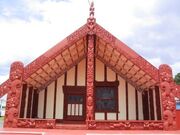Brawd ag Brawd ("Brother With Brother") | |||||||
| Anthem | "Parata E Parata" | ||||||
| Capital | Wyllyngtan | ||||||
| Largest city | Wyllyngtan | ||||||
| Language official |
Welsh | ||||||
| others | Maori | ||||||
| Religion main |
Maori Myths | ||||||
| others | Catholicism | ||||||
| Ethnic Groups main |
Maori | ||||||
| others | Welsh | ||||||
| Demonym | Maori | ||||||
| Government | Vassal State | ||||||
| Established | 1693 | ||||||
| Annexation | to Wales | ||||||
| date | 1730 | ||||||
New South Wales is a nation in Oceania. It is currently a vassal state of Wales . New South Wales occupies almost all of the former Maori Union, except for a small piece of land that is owned by the Mayans. Officially co-ruled by both a Welsh Governor and the Maori Council, New South Wales is currently being transformed for a tribal society to a progressing vassal state. New South Wales has a cool/warm temperate climate with a high maritime influence.
History[]

Seal of Maori Union, ca 1695
Koori Union[]
The history of New South Wales begins primarily with the now defunct nation of the Koori Union . The Koori Union was a tribal confederation that expanded rapidly throughout Australia in the late 1600s. With most of eastern Australia under Koori control, the chief looked to unite the Maori peoples into one nation - the Maori Union. This was the first time all Maoris had been united - and the only time to date.

Division of Maori Lands after First Great War
First Great War[]
During the Koori rise to power, European powers (including Wales) began to expand on to Australia, which was a result of Koori growth and prosperity. The Kooris managed to convince about half of the western world to join the KTC - or Koori Trading Company . This eventually turn into a Grand Council, and the Kooris, with their Maori vassals, declared war on Orissa and Italy on 1700. A massive war broke out, and the Maori Union was divided between Orissa and Ethiopia .
Second Great War[]
By 1710, tensions between the victors of the First Great War began to grow. All nations, while they realized massive casualties, also gained a lot of land. Power seemed to get to a lot of nations' heads, and by 1715 there were two factions of the winners of the First Great War - Germany/Arabian and Orissa/Ethiopia. War was inevitable, and Arabia attacked Ethiopia for Yemen. As a result of their involvement, Wales gained most of the Maori lands.
Government[]

Maori Council Building
The Government of New South Wales is divided into two branches - the Welsh Governor, who operates as the executive head of government, and the Maori Council, who operate as the legislative body of government. They both operate with each other.
The Welsh Governor is commissioned by the King of Wales himself, and serves for as long as the monarch chooses. He must be approved by the Welsh Parliament. He represents the King's interests, as well as the interests of the Welsh settlers on the islands,
The Maori Council is a group of elders from the main Maori tribes who meet in the capital to represent the native Maori population. They are chosen according to their tribes' customs.
Recognized Tribes[]
The following are recognized tribes of Maori that have an Elder on the Maori Council:
Tahu, Koata, Mamoe, Apa, Rangitane, Tama, Matungu, Ati Awa, Maru, Harua, Rauru, Te Ata, Paoa, Mahuta, Huia, Arawa, Tuhoe, Whakatohea, Tamanuhiri, and Porou.
There are 20 recognized tribes with Elders on the Maori Council. If there is a tie in a vote of the Maori Council, the Welsh Governor breaks the tie.
Economy[]
The economy of New South Wales consists of trade with various Welsh colonies (like De Mor Tir), whaling, sealing, and agriculture.
Foreign Relations[]
Positive:
- Mayans
- Japanese
Neutral:
- Italians
Negative:
- Orissa
- Mataram
| |||||||||||||||||||||||


